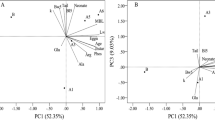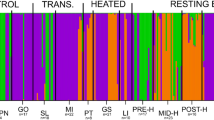Summary
A series of experiments revealed significant differences in the potential ability of seven Daphnia pulex genotypes to colonize two lakes in which this species does not naturally reside. Life table experiments, in which individuals from each genotype were raised separately on water and natural phytoplankton from the two lakes, revealed several significant differences among genotypes in life history traits, including age and size at first reproduction, clutch size and offspring body size. Significant differences among genotypes were also found in mean genotype fitness and rate of population increase, although all genotypes were able to increase in absolute numbers. Significant genotypexlake interaction was found for several life history traits and mean fitness, indicating that the relative success of invading genotypes may depend on habitat characteristics. Enclosure experiments, in which all seven genotypes were introduced together into enclosures in both lakes, revealed that some genotypes increased greatly while others declined in relative abundance, and that the most successful genotypes differed between lakes. In addition, the most successful genotypes in the enclosures were not necessarily the genotypes that displayed the highest fitness in the life table experiments, possibly because individuals in the enclosures competed for food resources, leading to exclusion of certain genotypes.
Similar content being viewed by others
References
Dodson SI (1981) Morphological variability of Daphnia pulex Leydig and related species from North America. Hydrobiologia 83:101–114
Folt C, Goldman CR (1981) Allelopathy between zooplankton: a mechanism for interference competition. Science 213:1133–1135
Hebert PDN (1974) Enzyme variability in natural populations of Daphnia magna I. Population structure in East Anglia. Evolution 28:546–556
Hebert PDN, Crease TJ (1980) Clonal coexistence in Daphnia pulex: another planktonic paradox. Science 207:1363–1365
Hebert PDN, Moran C (1980) Enzyme variability in natural populations of Daphnia carinata King. Heredity 45:313–321
Lenski RE, Service PM (1982) The statistical analysis of population growth rates calculated from schedules of survivorship and fecundity. Ecology 63:655–662
Lewontin RC (1965) Selection of colonizing ability. In: Baker HG, Stebbins GL (eds) The genetics of colonizing species. Academic Press, London, pp 77–94
Lynch M (1983) Ecological genetics of Daphnia pulex. Evolution 37:358–374
Lynch M (1984a) The genetic structure of a cyclical parthenogen. Evolution 38:186–203
Lynch M (1984b) The limits to life history evolution in Daphnia. Evolution 38:465–482
Lynch M (1985) Speciation in the Cladocera. Verh Int Ver Limnol 22:3116–3123
Lynch M, Weider LJ, Lampert W (1986) Measurement of the carbon balance in Daphnia. Limnol Oceanogr 31:17–33
Mort MA, Wolf HG (1985) Enzyme variability in large-lake Daphnia populations. Heredity 55:27–36
Neill WE (1978) Experimental studies on factors limiting colonization by Daphnia pulex Leydig of coastal montane lakes in British Columbia. Can J Zool 56:2498–2507
Rich SS, Bell AE, Wilson SP (1979) Genetic drift in small populations of Tribolium. Evolution 33:579–584
Service PM, Lenski RE (1982) Aphid genotypes, plant phenotypes and genetic diversity: a demographic analysis of experimental data. Evolution 36:1276–1282
Vanni MJ (1984) Biological control of nuisance phytoplankton by Daphnia pulex: experimental studies. In: Lake and reservoir Management. US EPA Rep EPA 440/5/84-001, pp 151–156
Vanni MJ (1986a) Fish predation and zooplankton demography: indirect effects. Ecology 67:337–354
Vanni MJ (1986b) Competition in zooplankton communities: suppression of small species by Daphnia pulex. Limnol Oceanogr 31:1039–1056
Weider LJ (1984) Spatial heterogeneity of Daphnia genotypes: vertical migration and habitat partitioning. Limnol Oceanogr 29:225–235
Weider LJ (1985) Spatial and temporal genetic heterogeneity in a natural Daphnia population. J Plankton Res 7:101–123
Weider LJ, Lampert W (1985) Differential response of Daphnia genotypes to oxygen stress: respiration rates, hemoglobin content and low-oxygen tolerance. Oecologia (Berlin) 65:487–491
Wright S (1969) Evolution and the genetics of populations, vol II. The theory of gene frequencies. Univ of Chicago Press, Chicago
Author information
Authors and Affiliations
Rights and permissions
About this article
Cite this article
Vanni, M.J. Colonization dynamics and life history traits of seven Daphnia pulex genotypes. Oecologia 72, 263–271 (1987). https://doi.org/10.1007/BF00379277
Received:
Issue Date:
DOI: https://doi.org/10.1007/BF00379277




